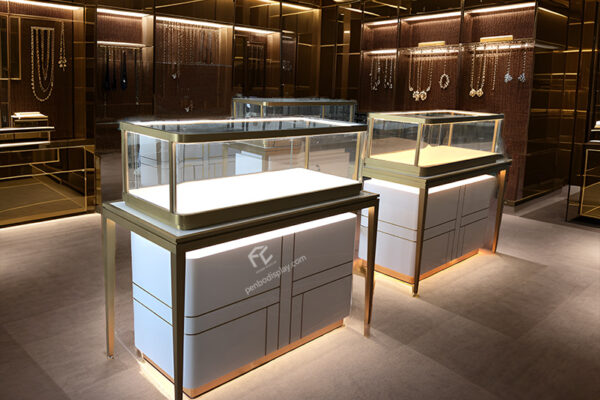In the jewelry industry, the presentation of precious items is just as important as the quality of the pieces themselves. A jewelry display case serves as the centerpiece of any jewelry store, enhancing the visual appeal of the items on display while also ensuring their safety and security. Carefully designed and strategically positioned, these cases are critical tools for retailers to attract customers and elevate the shopping experience.

The Purpose of a Jewelry Display Case
- Visual Appeal: The primary role of a jewelry display case is to present jewelry in an appealing and organized manner. A well-crafted case allows the pieces to be displayed in a way that highlights their finest features, such as the sparkle of a diamond or the intricate craftsmanship of a bracelet. By arranging jewelry thoughtfully, retailers can help customers focus on the beauty and uniqueness of each item.
- Protection: Jewelry is often made of valuable and jewelry display case delicate materials that can be easily damaged or stolen. Display cases offer protection from dust, environmental factors, and theft, with most designs incorporating secure locking systems and reinforced glass to keep the jewelry safe without compromising visibility.
- Organization: Display cases make it easy to categorize different types of jewelry—such as rings, necklaces, earrings, and bracelets—allowing customers to browse efficiently. They can be designed with individual compartments or shelves that provide optimal viewing angles for each piece.
Types of Jewelry Display Cases
- Countertop Display Cases: These are typically smaller cases placed on top of counters. Ideal for rings, earrings, and smaller items, countertop cases are a favorite for boutiques and small jewelry stores. They allow customers to have a closer look at the items without overwhelming the display area.
- Freestanding Display Cases: These larger cases are placed directly on the floor and are often used for showcasing high-value items such as diamond necklaces, luxury watches, or special collections. Freestanding cases provide more space for creative layouts and can often include multiple levels or rotating platforms.
- Wall-Mounted Display Cases: For stores with limited floor space, wall-mounted display cases offer a sleek solution. These cases are secured to the wall and often feature glass doors or panels that allow customers to view the jewelry from a distance.
- Rotating Display Cases: To maximize visibility, rotating display cases allow the jewelry to be viewed from all angles. These cases are ideal for displaying multiple items at once, ensuring that each piece gets attention as the case slowly rotates.
Key Features of a Jewelry Display Case
- Glass Quality: The type of glass used in a jewelry display case is important for both security and visibility. Tempered glass is often used because it is stronger and more resistant to impact than standard glass, reducing the risk of damage. It also ensures that customers get a clear, unobstructed view of the jewelry without glare or distortion.
- Lighting: Lighting is a crucial element in any jewelry display case. LED lights are commonly used because they produce bright, focused light that enhances the sparkle of gems and metals without generating heat. Some display cases also incorporate adjustable lighting, allowing retailers to focus light on specific pieces for greater emphasis.
- Security: High-end jewelry display cases often include additional security features, such as locks, alarms, and sensors. These systems ensure that valuable items are protected from theft while remaining accessible for display. Hidden security cameras may also be integrated into the design of the case.
